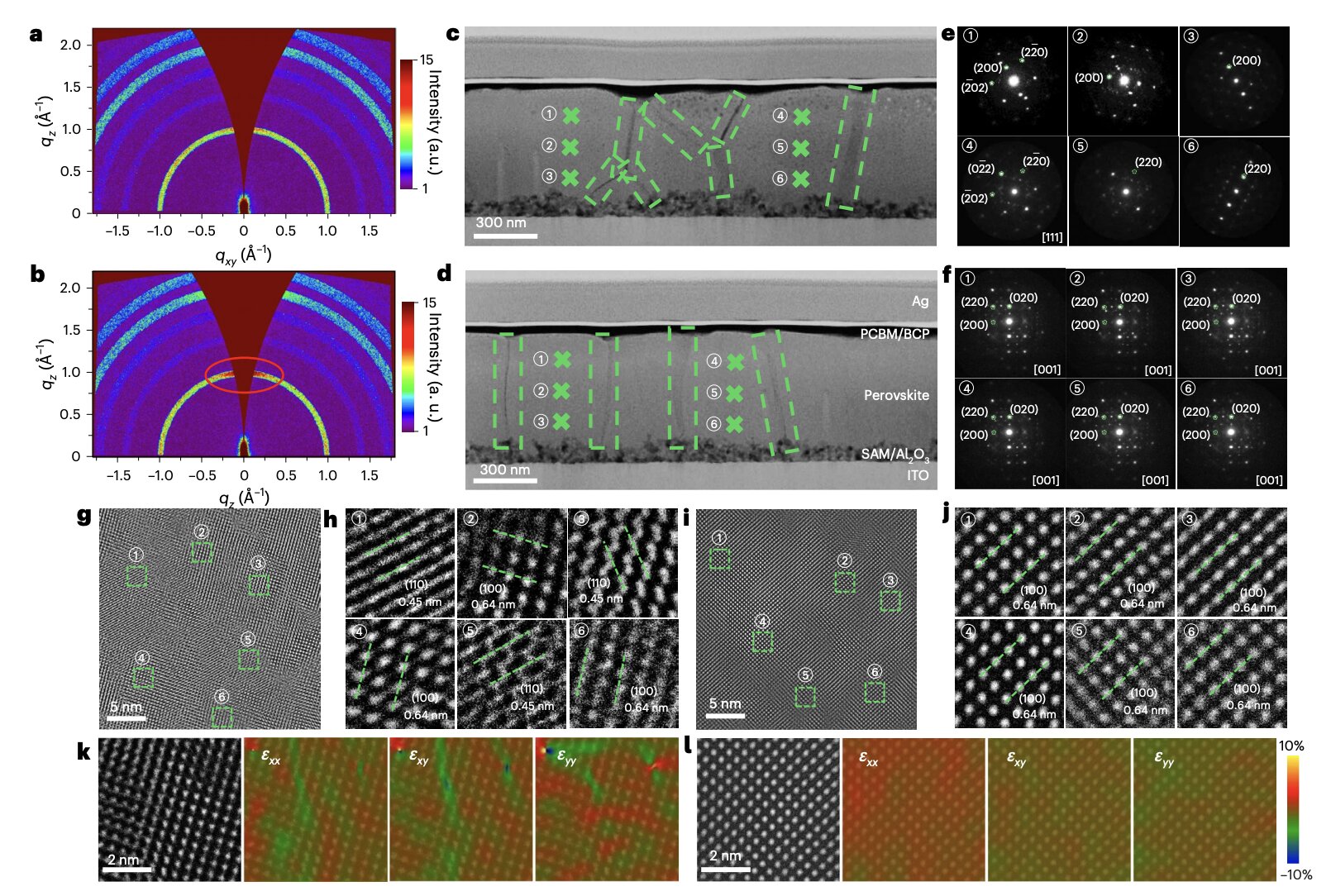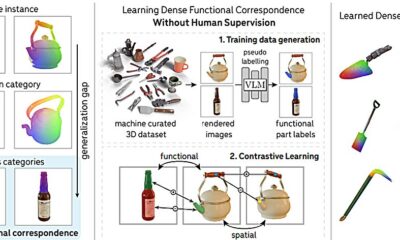Tech
Molecular engineering strategy boosts efficiency of inverted perovskite solar cells

Solar cells, devices that can directly convert radiation emitted from the sun into electricity, have become increasingly widespread and are contributing to the reduction of greenhouse gas emissions worldwide. While existing silicon-based solar cells have attained good performances, energy engineers have been exploring alternative designs that could be more efficient and affordable.
Perovskites, a class of materials with a characteristic crystal structure, have proved to be particularly promising for the development of low-cost and energy-efficient solar energy solutions. Recent studies specifically highlighted the potential of inverted perovskite solar cells, devices in which the extraction charge layers are arranged in the reverse order compared to traditional designs.
Inverted perovskite solar cells could be more stable and easier to manufacture on a large-scale than conventional perovskite-based cells. Nonetheless, most inverted cells developed so far were found to exhibit low energy-efficiencies, due to the uncontrolled formation of crystal grains that can produce defects and adversely impact the transport of charge carriers generated by sunlight.
Researchers at Huazhong University of Science and Technology recently devised a new molecular engineering strategy to control the crystallization of perovskite materials in inverted solar cells. This promising approach, outlined in a paper published in Nature Energy, entails mixing special naphthalene-based molecules into perovskites, to ensure that they grow more uniformly.
“Formamidinium and cesium metal halide perovskites enable high efficiency in inverted perovskite solar cells, but uncontrolled crystallization limits their performance,” wrote Qisen Zhou, Guoyu Huang and their colleagues in their paper. “We regulate the nucleation and growth of the perovskite through aromatic interactions between naphthalene ammonium salts and naphthalenesulfonates.”
Essentially, the researchers mixed naphthalene-based molecules into the perovskite solution to control the formation and growth of perovskite crystals. They found that the resulting perovskite films were uniform and had very few defects, which is highly favorable for the development of inverted solar cells.
“The ammonium groups of the naphthalene ammonium salts occupy the formamidinium site, while the sulfonate groups of the naphthalenesulfonates coordinate with lead ions,” explained the authors. “Their naphthalene moieties form tight aromatic stacking adjacent to the [PbI6]4− octahedra. These interactions promote ordered out-of-plane crystallization along the (100) plane, enhancing defect passivation and carrier transport.”
Zhou, Huang and his colleagues used the uniform perovskite films they created to fabricate inverted perovskite solar cells. They then tested the performance, efficiency and stability of these cells under continuous illumination.
“We achieve a power conversion efficiency of 27.02% (certified 26.88%) for inverted solar cells,” wrote the researchers. “Encapsulated devices retain 98.2% of their initial efficiency after 2,000 h of maximum power point tracking under continuous illumination in ambient air. Furthermore, we demonstrate a certified steady-state efficiency of 23.18% for inverted mini-modules with an aperture area of 11.09 cm2 and a certified efficiency of 29.07% for all-perovskite tandem solar cells.”
The initial results gathered by this research team are highly promising, highlighting the promise of their molecular engineering approach for the development of energy-efficient inverted perovskite solar cells. In the future, their strategy could be further refined to achieve additional efficiency gains and used to realize high-quality perovskite films with varying compositions.
Written for you by our author Ingrid Fadelli, edited by Lisa Lock, and fact-checked and reviewed by Robert Egan—this article is the result of careful human work. We rely on readers like you to keep independent science journalism alive.
If this reporting matters to you,
please consider a donation (especially monthly).
You’ll get an ad-free account as a thank-you.
More information:
Qisen Zhou et al, Aromatic interaction-driven out-of-plane orientation for inverted perovskite solar cells with improved efficiency, Nature Energy (2025). DOI: 10.1038/s41560-025-01882-x
© 2025 Science X Network
Citation:
Molecular engineering strategy boosts efficiency of inverted perovskite solar cells (2025, October 28)
retrieved 28 October 2025
from https://techxplore.com/news/2025-10-molecular-strategy-boosts-efficiency-inverted.html
This document is subject to copyright. Apart from any fair dealing for the purpose of private study or research, no
part may be reproduced without the written permission. The content is provided for information purposes only.
Tech
OpenAI says a million ChatGPT users talk about suicide

Data from ChatGPT-maker OpenAI suggest that more than a million of the people using its generative AI chatbot have shown interest in suicide.
In a blog post published on Monday, the AI company estimated that approximately 0.15% of users have “conversations that include explicit indicators of potential suicidal planning or intent.”
With OpenAI reporting more than 800 million people use ChatGPT every week, this translates to about 1.2 million people.
The company also estimates that approximately 0.07% of active weekly users show possible signs of mental health emergencies related to psychosis or mania—meaning slightly fewer than 600,000 people.
The issue came to the fore after California teenager Adam Raine died by suicide earlier this year. His parents filed a lawsuit claiming ChatGPT provided him with specific advice on how to kill himself.
OpenAI has since increased parental controls for ChatGPT and introduced other guardrails, including expanded access to crisis hotlines, automatic rerouting of sensitive conversations to safer models, and gentle reminders for users to take breaks during extended sessions.
OpenAI said it has also updated its ChatGPT chatbot to better recognize and respond to users experiencing mental health emergencies, and is working with more than 170 mental health professionals to significantly reduce problematic responses.
© 2025 AFP
Citation:
OpenAI says a million ChatGPT users talk about suicide (2025, October 28)
retrieved 28 October 2025
from https://techxplore.com/news/2025-10-openai-million-chatgpt-users-suicide.html
This document is subject to copyright. Apart from any fair dealing for the purpose of private study or research, no
part may be reproduced without the written permission. The content is provided for information purposes only.
Tech
Novel textile can adjust its aerodynamic properties on demand

Imagine a road cyclist or downhill skier whose clothing adapts to their wind speed, allowing them to shave time just by pulling or stretching the fabric.
Such cutting-edge textiles are within reach, thanks to researchers at the Harvard John A. Paulson School of Engineering and Applied Sciences (SEAS). Led by SEAS mechanical engineering graduate student David Farrell, a study published in Advanced Materials describes a new type of textile that uses dimpling to adjust its aerodynamic properties while worn on the body. The research has the potential to change not only high-speed sports, but also industries like aerospace, maritime, and civil engineering.
The research is a collaboration between the labs of Katia Bertoldi, the William and Ami Kuan Danoff Professor of Applied Mechanics, and Conor J. Walsh, the Paul A. Maeder Professor of Engineering and Applied Sciences.
On-demand golf ball dimples
Farrell, whose research interests lie at the intersection of fluid dynamics and artificially engineered materials, or metamaterials, led to the creation of a unique textile that forms dimples on its surface when stretched, even when tightly fitted around a person’s body. The fabrics utilize the same aerodynamic principles as a golf ball, whose dimpled surface causes a ball to fly farther by using turbulence to reduce drag. Because the fabric is soft and elastic, it can move and stretch to change the size and shape of the dimples on demand.
Adjusting dimple sizes can make the fabric perform better in certain wind speeds by reducing drag by up to 20%, according to the researchers’ experiments using a wind tunnel.
“By performing 3,000 simulations, we were able to explore thousands of dimpling patterns,” Farrell said. “We were able to tune how big the dimple is, as well as its form. When we put these patterns back in the wind tunnel, we find that certain patterns and dimples are optimized for specific wind-speed regions.”
Farrell and team used a laser cutter and heat press to create a dual-toned fabric made of a stiffer black woven material, similar to a backpack strap, and a gray, softer knit that’s flexible and comfortable. Using a two-step manufacturing process, they cut patterns into the woven fabric and sealed it together with the knit layer to form a textile composite. Experimenting with multiple flat samples patterned in lattices like squares and hexagons, they systematically explored how different tessellations affect the mechanical response of each textile material.
Lattice pattern
The textile composite’s on-demand dimpling is the result of a lattice pattern that Bertoldi and others have previously explored for its unusual properties. Stretch a traditional textile onto the body, and it will smooth out and tighten. “Our textile composite breaks that rule,” Farrell explained. “The unique lattice pattern allows the textile to expand around the arm rather than clamp down.
“We’re using this unique property that [Bertoldi] and others have explored for the last 10 years in metamaterials, and we’re putting it into wearables in a way that no one’s really seen before,” Farrell said.
More information:
David T. Farrell et al, Programmable Surface Dimpling of Textile Metamaterials for Aerodynamic Control, Advanced Materials (2025). DOI: 10.1002/adma.202505817
Citation:
Novel textile can adjust its aerodynamic properties on demand (2025, October 28)
retrieved 28 October 2025
from https://techxplore.com/news/2025-10-textile-adjust-aerodynamic-properties-demand.html
This document is subject to copyright. Apart from any fair dealing for the purpose of private study or research, no
part may be reproduced without the written permission. The content is provided for information purposes only.
Tech
Video conferencing apps can leak location data through audio channels despite privacy controls

Since the COVID-19 pandemic, video conferencing platforms like Zoom and Microsoft Teams have become essential for work, education, and social connections. While these platforms offer controls such as disabling cameras and muting microphones to safeguard user privacy, a new study suggests that video conferencing may not be as secure as many assume.
SMU computer scientists have discovered that even with cameras turned off and virtual backgrounds in use, attackers can actively and covertly probe a user’s physical location by exploiting the two-way audio channels of video conferencing apps.
The mechanism works through “remote acoustic sensing,” allowing an attacker to probe users’ physical surroundings by injecting malicious sounds and analyzing the location-specific audio feedback, or echoes.
In a study published as part of the 2025 IEEE Symposium on Security and Privacy , the research team tested popular apps such as Zoom and found that proposed attacks were able to recognize user’s locations or location contexts with 88% accuracy, whether the user was in the same place multiple times or had never been there before.
“The results raise a severe privacy concern since any video conferencing participant could invade each other’s location privacy easily without malware installation,” said SMU principal investigator Chen Wang, O’Donnell Foundation Endowed Professor of computer science at SMU Lyle School of Engineering.
This type of cybersecurity—known as “sniffing location privacy”—is particularly alarming because there’s very little users can do to secure videoconferencing, Wang said.
“Even a vigilant user who carefully unmutes the microphone only when speaking remains vulnerable: an adversary can exploit the few silent seconds between unmuting and muting, since people naturally leave margins to ensure their speech is fully heard,” he noted. “Furthermore, we find that when a user speaks, echo sounds return with higher energy, because video conferencing systems apply acoustic suppression to silent user ends to eliminate meaningless feedback.”
As a result, the user’s speech effectively amplifies the malicious signal feedback.

Another issue is that the probing sounds can be as short as 100 milliseconds, giving attackers sufficient information before a victim would have time to notice.
Wang and his team are currently working on defense algorithms that can be deployed at the video conferencing server to detect and delete suspicious probing sounds before forwarding audio to participants, along with other ways to defend against an adversary being able to sense our surroundings or “see where we are.”
Why your conference call may not be as secure as you think
SMU researchers identified two types of echo attacks that are noninvasive enough to go unnoticed by the victim: the in-channel echo attack, which uses carefully crafted signals to bypass echo cancellation, and the off-channel echo attack, which hijacks everyday sounds like email notifications to slip past defenses undetected.
These methods could allow a thief or spy, for instance, to learn when you are at home. An adversary can also determine where the user is whenever they meet online, even if the user is using a virtual background.
The research team’s findings are based on six-month experiments at 12 different locations, ranging from homes and offices to vehicles and hotels.
“We all know that video conferencing systems utilize echo cancellation functions to suppress audio feedback and ensure call quality,” Wang said. “However, we find that an adversary can leverage generative AI encoders to counteract such echo cancellation mechanisms and extract stable location embeddings from severely suppressed echo signals, even though they are nearly imperceptible to human listeners.”
More information:
Long Huang et al, Sniffing Location Privacy of Video Conference Users Using Free Audio Channels, 2025 IEEE Symposium on Security and Privacy (SP) (2025). DOI: 10.1109/sp61157.2025.00260
Citation:
Video conferencing apps can leak location data through audio channels despite privacy controls (2025, October 28)
retrieved 28 October 2025
from https://techxplore.com/news/2025-10-video-conferencing-apps-leak-audio.html
This document is subject to copyright. Apart from any fair dealing for the purpose of private study or research, no
part may be reproduced without the written permission. The content is provided for information purposes only.
-

 Fashion1 week ago
Fashion1 week agoChinese woman charged over gold theft at Paris Natural History Museum
-

 Entertainment1 week ago
Entertainment1 week agoJohn Grisham unveils his first-ever mystery, “The Widow”
-

 Tech1 week ago
Tech1 week agoThis Smart Warming Mug Is Marked Down by $60
-

 Fashion1 week ago
Fashion1 week agoeBay UK seller fee removal sends revenue down but profits rise
-

 Tech1 week ago
Tech1 week agoEaster Island’s Moai Statues May Have Walked to Where They Now Stand
-

 Fashion1 week ago
Fashion1 week agoThe North Face and Cecilie Bahnsen launch second collaboration
-

 Tech1 week ago
Tech1 week agoOpenAI has slipped shopping into ChatGPT users’ chats—here’s why that matters
-

 Tech1 week ago
Tech1 week agoAI model could boost robot intelligence via object recognition


















